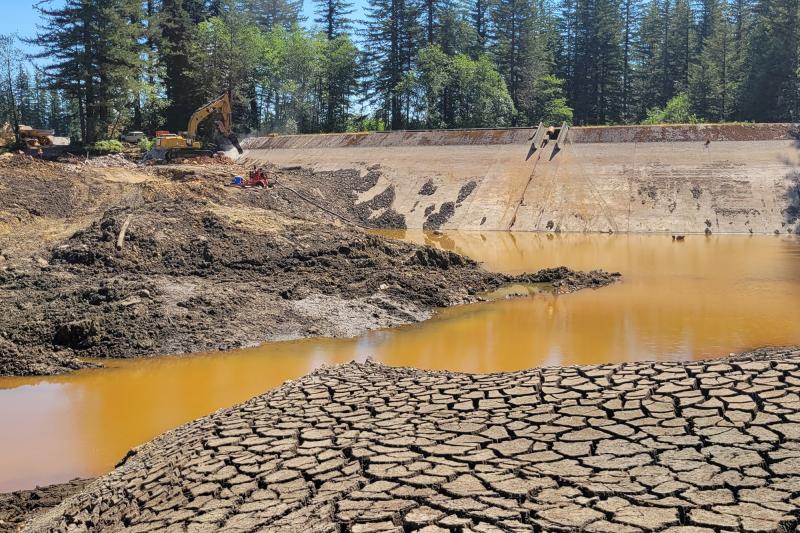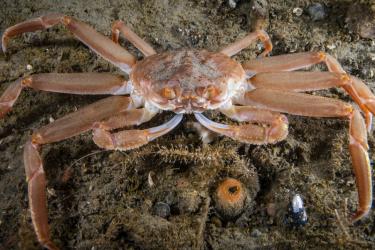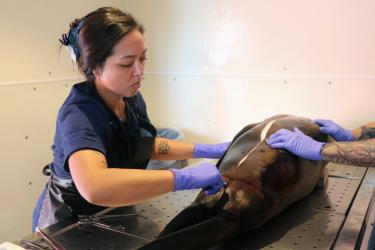In Southeast Washington, NOAA funding is supporting the Cowlitz Indian Tribe’s goal of restoring 30 percent or more of the salmon and steelhead habitat on its traditional lands in the lower Columbia River watershed. NOAA Fisheries’ Office of Habitat Conservation awarded the Tribe $3.3 million to remove the 55-foot-tall, 425-foot-long Kwoneesum Dam on Wildboy Creek. The dam, which was removed in 2024, blocked upstream salmon and steelhead migration on the creek for almost 60 years.
We partner with tribes across the United States to restore fish habitat on their ancestral lands. This enables tribal and community members to one day renew harvesting species that declined or disappeared due to habitat degradation and other impacts.
The Kwoneesum Dam project:
- Restored access to 6.5 miles of spawning and rearing habitat for threatened summer steelhead and coho salmon
- Restored 1.3 miles of stream channel
- Constructed 75 logjam structures and 12 pools for juvenile fish rearing
- Planted 37,550 native trees and shrubs to reforest the dam reservoir footprint
- Placed approximately 15,000 cubic yards of rock and spawning gravels to rebuild the degraded stream bed
This year, staff members have already spotted adult steelhead and their redds (salmon nests) as well as coho in the restored area. They hope the fish are the first of many more to come. The populations are beginning to grow to where they may support tribal fisheries, as well as broader commercial and recreational fisheries.
“We see restoration as the key to the future of our Tribe,” says William Iyall, Chairman of the Cowlitz Indian Tribe. “We hope that future generations will be able to reap the benefits of these resources. We want to be sure that it is substantial enough for everybody to use.”
Degradation of Salmon and Steelhead Habitat
Wildboy Creek feeds into the Washougal River watershed, one of the major sub-basins of the Lower Columbia River. The watershed once hosted thousands of winter and summer steelhead, as well as Chinook, chum, and coho salmon, which migrated up its cold-water tributaries to spawn.
Since time immemorial, the Cowlitz Indian Tribe burned vegetation in ways that promoted the growth of edible plants and created grazing areas for game animals. It also made habitat more diverse and productive for fish.
The Tribe lost access to their lands in the late 1800s after the land was opened for settlement. Over time, the Washougal watershed was dammed and degraded. Lower Columbia River salmon and steelhead populations declined and some species were added to the Endangered Species list.
The Kwoneesum Dam
A lumber company first dammed Wildboy Creek to float logs downstream to lumber mills. In 1965, the Camp Fire Girls organization built the Kwoneesum Dam to create a 9-acre reservoir for recreational summer camp activities. The dam cut salmon off from upstream access to spawning and juvenile rearing habitat, while starving downstream channels of wood and gravel.
Salmon and steelhead require specific-sized gravels for constructing their redds, while woody debris traps gravel and creates complex underwater habitat for juvenile fish. Without these, the downstream portion of Wildboy Creek also became inhospitable for fish. Rising stream temperatures exacerbated these issues. Water in the sun-baked reservoir warmed to 70°F or higher, too hot for cold water-loving salmon and steelhead.
The dam’s age made it vulnerable to failure, threatening homes and other structures downstream. In 1997, the reservoir was accidentally emptied. Millions of gallons of warm water and backed-up sediment flowed downstream, resulting in a massive fish kill.
After years of effort, the Tribe’s partner, Columbia Land Trust, acquired the 1,300-acre site in 2020. By this time, the Tribe had established itself as one of the leading habitat restoration organizations in the region. Through the Infrastructure Investment and Jobs Act, NOAA awarded the tribe $2.3 million to complete the demolition of the dam and rehabilitate the degraded stream habitat.
Restoring Wildboy Creek
The Tribe successfully removed the dam and completed the major restoration tasks in September 2024.
“It’s such a rare opportunity to completely remove a dam, especially in partnership with a tribe,” says NOAA Marine Habitat Restoration Specialist Chemine Jackels. “NOAA is incredibly excited to see how salmon and steelhead will use and repopulate the habitat, knowing that this project brings them a little closer to recovery.”
“This was an extremely challenging project, but our restoration mantra is ‘intensive and extensive,’” said Peter Barber, Habitat Restoration Program Manager for the Tribe. “Large-scale restoration is the only way we're going to move the recovery dial for salmon and steelhead.”
After fish and other species were removed from the project site, contractors pumped 20 million gallons of water out of the reservoir. They temporarily rerouted the three tributaries that feed Wildboy Creek. The team had to carefully manage the dewatering process to prevent sediment from entering the tributaries, which could result in fish kills.
Following the dam removal, they began restoring the Wildboy Creek channel downstream of the dam. The channel had sections of exposed bedrock from previous historic log drives and restricted sediment transport due to Kwoneesum dam.
“We delivered and installed 850 logs, 15,000 cubic yards of rock, gravel, and boulders, and rebuilt an entire half-mile of Wildboy stream bed and almost a mile of tributary channel,” says Barber. Workers reconnected the three tributaries to Wildboy Creek in the reservoir footprint and planted thousands of trees and shrubs. The trees will eventually shade the creek, cooling water temperatures.
It will take time for significant numbers of salmon and steelhead to begin using the newly opened habitat. However, the project team spotted salmon and steelhead exploring the area this spring.
“I never would have assumed coho would occupy this site in the first year—I am completely shocked, but excited,” says Barber. “We know steelhead have spawned and I expect to see juveniles swimming around in a few more weeks. I believe this site could potentially be loaded with rearing juvenile salmonids in another 2 months.”
In the meantime, the Cowlitz Indian Tribe is moving forward with another NOAA-funded project. This summer, the Tribe plans to remove a 135-foot-long culvert and abandoned railroad crossing. They block access to 13.9 miles of habitat located upstream on Ostrander Creek, a tributary of the lower Cowlitz River.
“We protect this land with the hope that one day we’ll have the right to come and fish on our homelands,” says Iyall. “It’s critical to do our part. We've always given more than we take.”







